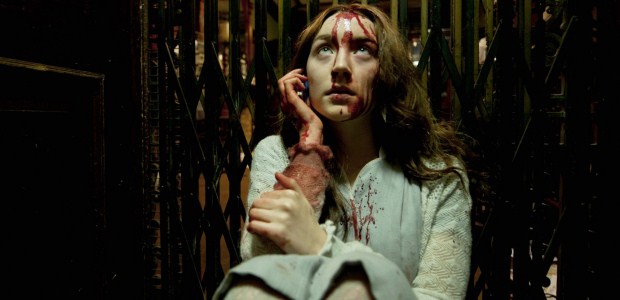Director Neil Jordan’s Interview With a Vampire: The Vampire Chronicles (1994), based on a 1976 novel of the same name by Anne Rice, was one of the first films to break some of the ground rules known to exist within the cinematic realm of vampires. With no connection whatsoever, Jordan returns to the world of vampires by using his 1994 film as a selling point for Byzantium – a modern vampire film that goes on to break more rules by turning vampire-ism into an enigma rather than feeding off existing myth. It works, for the most part, by using a slack definition of the word Byzantium – the transition of flawed ancient Europe into a more aesthetically pleasant but equally flawed modern Europe.
Conceptually, this works as a metaphor in relating the film’s premise where a curse from the past clutches onto the heels of the present. It is this curse that causes Clara Webb (Gemma Arterton) and her daughter Eleanor (Saoirse Ronan) to flee from town to town every now and again. They have been doing this for over 200 years and for two reasons – Clara and Eleanor are the only female vampires that exist. This doesn’t sit well with a misogynistic sect of all-male vampires that have formed a brotherhood. The other reason has more to do with how they feed. Clara is a creature of the night in more ways than one. Forced into prostitution during the Napoleonic wars, Clara is the bread winner as she continues to thrive by selling her body, and then draining the blood from her customers in the most gruesome manner imaginable. Eleanor doesn’t approve of her mother’s brutal feeding habits. Instead, she prefers subtle mercy killings by connecting with the elderly or terminally ill and saving them from their last days of misery and pain. While mother and daughter question each other’s ethics, the body count piles on and so they must relocate frequently in an effort to evade assassins from the aforementioned brotherhood.
Just like its main characters, Byzantium burns bridges from the past. Gone are the days when holy water, crucifixes, and other church relics were used to repel vampires. You won’t find them galloping up trees or dashing through the woods either, and thankfully, none of the other puerility from the Twilight franchise. What works here is the mood Jordan creates by generating a distinct aura around both these vampires. Hypnotic in their own way, Eleanor dwells in solitude, often chronicling events in their life, while Clara is a voluptuous seductress with little restrain between her wants and her needs. Eleanor’s journal also serves as a narration for the film while flashing back and forth between the present and the past. Through this we learn how they are different yet why their umbilical dependency is stronger than ever. Both Ronan and Arterton are equally effective in portraying their characters in a way that it becomes hard to establish who is in the lead. But if were to choose, I would say Ronan’s narration from her journal and her melancholy aids the Gothic atmosphere of the story. That being said, Arterton’s scenes are delicious eye-candy, nonetheless, and in turn keeps the story chugging along.
Using passages from Eleanor’s journal as flashbacks, Jordan takes us back and forth till we reach a mystical island – a secret location that ‘turns’ a mortal into a vampire. This part of the story is a bit murky but throws a new spin on the vampire origins story. I wouldn’t call this clever, but like Tomas Alfredson’ Let the Right One In, Jordan’s Byzantium is a departure from recent vampire films that seem to glorify the undead with unending superhero abilities. What we see instead, is the inner frailty of these creatures and how they choose to survive by feeding on the living. Even so, Jordan doesn’t forget that this is in fact a story about blood lust. Watch out for some gratuitous scenes of pure hemoglobin; enough to run waterfalls red!
Rating: 




